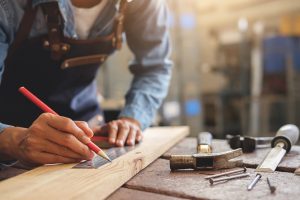With loads of time in your hands, thoughts of fixing the house or starting a small project can awaken the builder inside you. Once you start your small projects, there’s no going back, and it might be time to create your own workshop. However, a hammer and a saw won’t be enough for serious projects, and you’ll need a few more items and equipment to build like a pro.
Safety Gear
Accidents happen everywhere, particularly in woodworking. Accident rates for woodworking in the UK are 17 percent higher compared to other industries. Accidents at home are relatively common, so a few safety measures are required. Use safety goggles and not just regular spectacles. Working on wood creates a lot of dust, and a wayward splinter can break off and permanently damage your eye. Wood dust can also irritate your nose and throat or get in your lungs.
Dust masks should always be handy, and you might need a system to vent the dust outside for large projects. Splinters are common when handling wood, but safety gloves can eliminate their occurrence. Gloves used by construction workers are the best option. These gloves will protect you from minor cuts and abrasions while allowing you to work unimpeded. Boots or protective footwear will also ensure the safety of your feet when you drop a massive piece of wood or a tool by accident.

The Basic Table Saw
Every serious woodworking shed will have a table saw. Consult a few friends before heading to the hardware for a proper model. Opt for one with guards and install it per the instructions. Make sure the start button has a cover guard or install one yourself to prevent accidental starts. Don’t forget to ground your saw because one errant spark combined with wood dust can set your shed ablaze.
Make sure your shed has adequate lighting. It’ll keep your measurements accurate, and you don’t want hidden debris flying off the moment you start your saw. Give the guide a thorough reading and get a feel for your table saw by making practice cuts on a few pieces of wood. Once you master the table saw, you can purchase more complex or specialized woodworking tools to expand your craft.
Keeping Things Together
Cutting or shaping wood is only one part of woodworking. You’ll also have to put the pieces together. Simple projects can require basic nailing or screwing. But soon, you’ll be crafting interlocking pieces that would be better connected with a bit of glue. Equip your shed with a few sets of nails and screws for your early projects as well as carpenter’s glue or polyurethane glue for more subtle and intricate works. Polyurethane glue fumes can be toxic at high concentrations, so make sure to keep your shed ventilated when working with it.
There’s no better feeling than when a project comes to fruition, and you see something built with your own hands. The journey to becoming an expert woodworker can be a long one, but you can give it a start in your shed quite easily.

